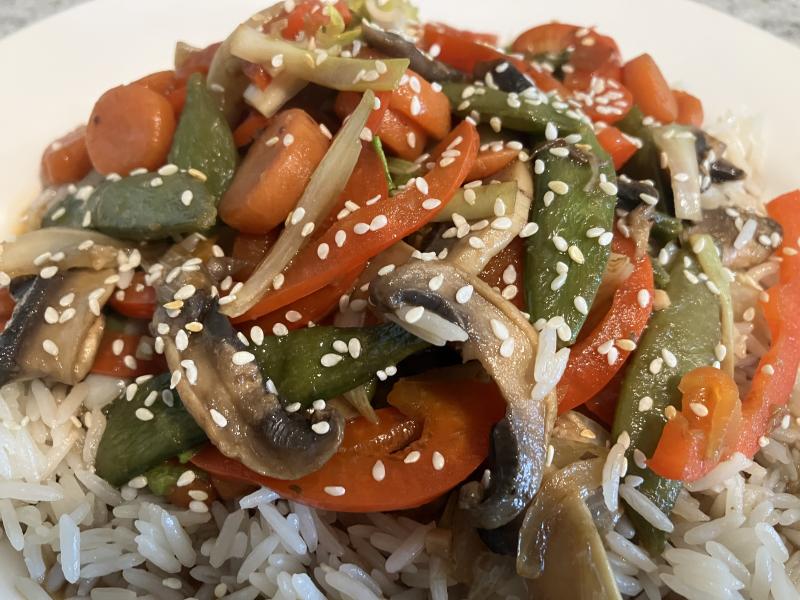The key to stir-fry success is mostly in the prep work
On a recent visit to Rays Produce at the Brush Factory on Kings, I looked unsuccessfully for bok choi. On my way out, I spoke to the owner, who told me to check again on my next visit. Although I didn’t find those baby greens, I did come home with mushrooms, spring onions, red pepper, carrots and snow peas, everything I needed for a veggie stir-fry.
By way of explanation, the term “stir-fry” is not a specific recipe, but rather a cooking technique that originated in China. The approach is to use a wok – a bowl-shaped pan with a flat bottom and high sides that concentrate the trapped heat. This allows the chef to use very little oil and very high heat to swiftly cook the ingredients in the dish.
The history of the wok dates back centuries to when peasants had to use dried manure or straw as fuel. Because these materials burn quickly, the frying pan with thin walls and a conical shape was developed so all the ingredients gather in the center, as close as possible to the heat. With the advent of better stoves and more reliable fuel, the necessity for a wok hasn’t persisted, but the technique and the tool have never fallen out of favor.
If you have been to a Chinese restaurant, you have likely heard the hissing sounds of food cooking in a wok, along with the occasional clatter when utensils strike the metal pan as the chef keeps the ingredients moving. This ensures everything receives adequate contact with the hot pan, so the contents are quickly steamed, retaining more nutrients and freshness than with other cooking methods.
To prepare a stir-fry in a wok, there are some key considerations, the first of which is to arrange all your ingredients in advance. This entails cutting your vegetables into similar-sized pieces so they will cook in roughly the same amount of time. Be sure to use an oil with a high smoke point, so you don’t impart a burned flavor to your food. Good choices are canola and peanut oils. Heat the wok before adding the oil and before the ingredients go into the pan.
Because various ingredients have different cooking times, if you are including a protein in your dish, it is preferable to cook that first, then remove it to a plate while you cook the aromatics and vegetables. It is also handy to mix up your sauce and have it ready to go into the dish all at once, after you return the cooked protein to the pan for the final moments over the heat.
I didn’t use any protein in the veggie stir-fry, although you could feature shrimp, cubed chicken, or threads of thinly sliced pork or beef. For a vegetarian protein, consider tofu (from soybeans) or seitan (made from wheat gluten). The final dish (see photo) includes rice piled high with colorful, crisp-tender vegetables in a savory sauce.
The sauce can be made from a wide range of ingredients. I usually combine soy sauce, sesame oil, rice wine vinegar, fish sauce and stock. Some recipes include cornstarch to serve as a thickener. I prefer to leave that out because I don’t like the texture it creates, but if you want a shiny, thicker sauce, by all means stir it into your sauce.
I’ve included a recipe for a basic veggie stir-fry and one for a chicken stir-fry. For both of these, you can add, delete or substitute other vegetables to meet your preferences. I’ve used two different sauces, so you can decide which you prefer. And, if you don’t have a wok, reach for a deep skillet.
Vegetable Stir-Fry
Peel the onion and cut into thin crescents; set aside. Cut the pepper into thin slices or matchsticks; set aside. Thinly slice the mushrooms; set aside. Thinly slice the celery, keeping a few leafy greens; set aside. In a small bowl, whisk together soy sauce, fish sauce, sesame oil, rice wine vinegar and vegetable stock; set aside. In a wok or deep skillet, heat the oil over high until it shimmers. Add chopped vegetables and stir constantly until they are crisp-tender, about 3 minutes. Add garlic and ginger; cook another minute. Pour in sauce and stir to coat. Remove from heat and serve over rice, garnished with sesame seeds. Yield: 4 servings.
Chicken Stir-Fry
In a small bowl, whisk together cornstarch and broth until smooth. Stir in soy sauce, honey, sesame oil and red pepper flakes; set aside. Add 1 T oil to a wok over medium-high heat. Sprinkle chicken pieces with salt and pepper. When oil is shimmering, add chicken to the pan. Cook, stirring often until cooked through, about 3 or 4 minutes. Remove chicken to a plate. Add broccoli and bell pepper; cook until crisp-tender, about 2 or 3 minutes. Add ginger and garlic; cook another minute. Return chicken to skillet; stir to combine. Pour sauce into the pan and stir to coat. Bring to a boil, then reduce heat and simmer until thickened, about 1 minute. Serve over rice. Yield: 4 servings.




















































